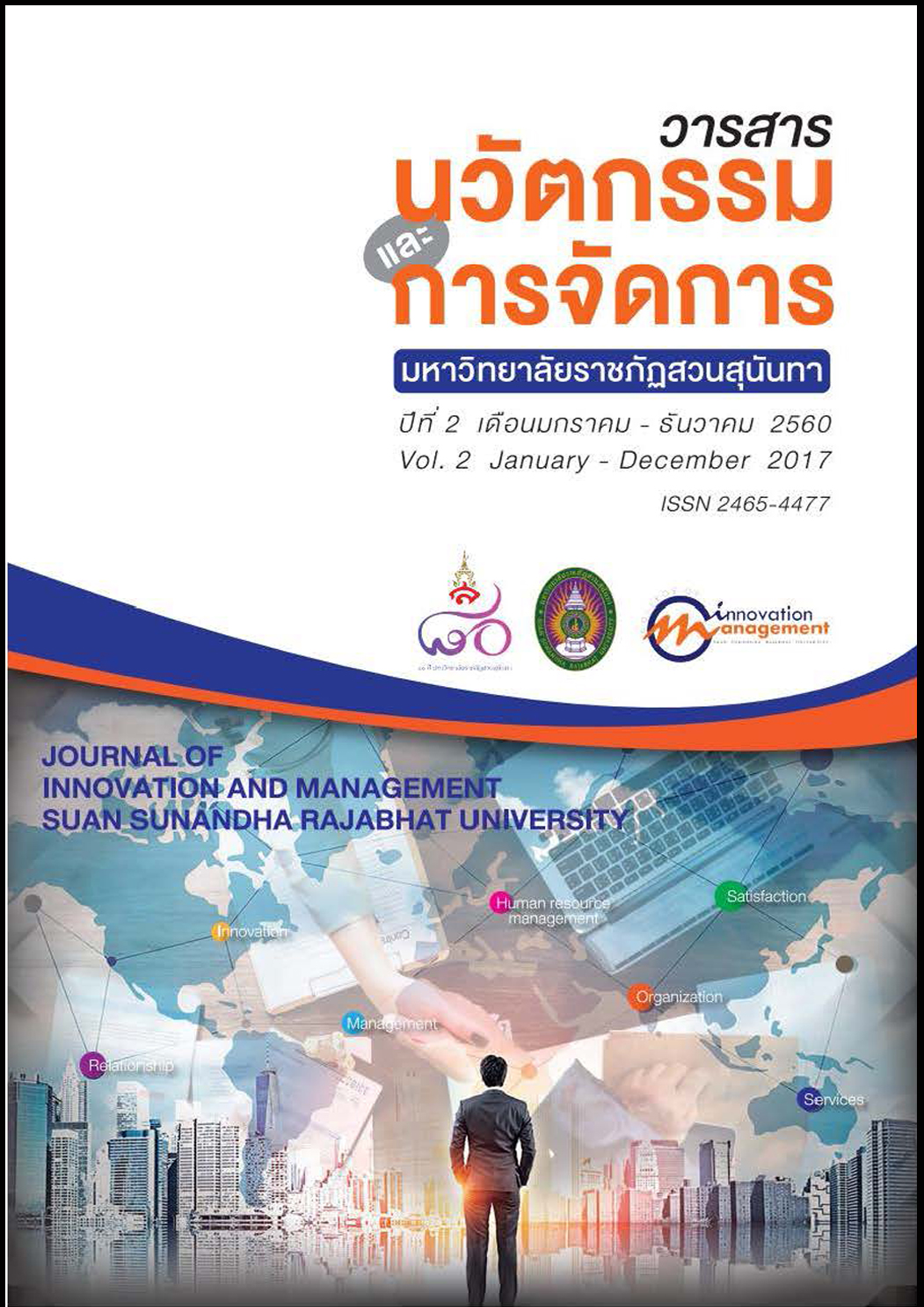อิทธิพลทางตรงของการเปลี่ยนวิธีจับเวลาประกวดแข่งขันนกปรอดหัวโขนเคราแดง
คำสำคัญ:
การเปลี่ยน, การจับเวลา, ประกวดแข่งขัน, นกปรอดหัวโขนเคราแดงบทคัดย่อ
การวิจัยมีวัตถุประสงค์เพื่อศึกษา (1) สภาพทั่วไปของตัวแปรคุณลักษณะพื้นฐานบุคคล กลุ่มสังคม ความต้องการ ความรู้ การบริหารจัดการ และการเปลี่ยนวิธีการจับเวลา และ (2) อิทธิพลทางตรงของคุณลักษณะพื้นฐานบุคคล กลุ่มสังคม ความต้องการ ความรู้ การบริหารจัดการที่มีต่อการเปลี่ยนวิธีการจับเวลา ใช้ระเบียบวิธีการวิจัย 2 วิธี แนว ทางเชิงปริมาณใช้แบบสอบถามเก็บข้อมูลจากผู้เลี้ยงนกเพื่อประกวดแข่งขันจำนวน 237 รายจาก การสุ่มตัวอย่างแบบเฉพาะเจาะจง วิเคราะห์ข้อมูลด้วยสถิติพรรณนาและเทคนิคการวิเคราะห์เส้นทาง แนวทางเชิงคุณภาพเก็บข้อมูลกับผู้เลี้ยงนกเพื่อประกวดแข่งขันจำนวน 13 ราย ด้วยการสัมภาษณ์เจาะลึก การสนทนากลุ่ม การบันทึกสนาม และบันทึกความจำ ผลการวิจัยพบว่า การบริหารจัดการมีอิทธิพลทางตรงมากที่สุดต่อการเปลี่ยนวิธีการจับเวลาแข่งขันนกปรอดหัวโขนเคราแดง
References
2. Alternative factor structures, nomological validity, and organizational outcomes. Journal of Business Ethics, 130(2), 485-506.
3. Amiot, C., Lorvelec, O., Dalger, I.M., Sardella, A., Lequilliec, P., & Clergeau, P. (2007). Rapid morphological divergence of introduced Red-whiskered Bulbuls Pycnonotus jocosus in contrasting environments. International journal of avian science, 149(3), 482-489.
4. Bonnycastle, M.M. (2015). Engaging with qualitative data analysis: The metaphor of "Looking at data like a landscape to be explored". The qualitative report, 20(1), 84-86.
5. Creswell, J. (2014). Research design: qualitative, quantitative and mixed methods approaches. 4th ed. Retrieved April 14, 2017, from https://www.amazon.com/ Research-Design-Qualitative-Q uantitative-Approaches/dp/145222
6. Fusch, P. I., & Ness, L. R. (2015). Are we there yet? Data saturation in qualitative research. The Qualitative Report, 20(9), 1408-1416.
7. Government Gazette. (2014). Wildlife Protection and Protection Act, No. 3, 2014. Page 4, Volume 131, Episode 89A. (in Thai)
8. Hassani, H. and Silva, E.R. (2015). A kolmogorov-smirnov based test for comparing the predictive accuracy of two sets of forecasts. Econometrics, 3, 590-609.
9. Hecimovich, M.D., & Hebert, J.J. (2016). Reliability and concurrent validity of an alternative method of lateral lumbar range of motion in athletes. SAJSM, 28, 23-26.
10. Homing pigeons. (2017). Benzing worlds best racing pigeons electronic timing system. Retrieved April 18, 2017, from http://www.homingpigeons.co.uk/contact.htm
11. Johnes, M. (2007). Pigeon racing and working class culture in Britain, c.1870-1950. Cultural and Social History, 4(3), 361–383.
12. Lewis, J.K. (2016). Using ATLAS.ti to facilitate data analysis for asystematic review of leadership competencies in the completion of a doctoral dissertation. Retrieved April 7, 2017, from: http://digitalcommons.Salve.edu/cgi/viewcontent.cgi?article=1067 &context=f ac_ staff_pub
13. Mathers, N., Fox, N., & Hunn, A. (2009). Surveys and questionnaires. Retrieved April 16, 2017, From: https://www.rds-yh.nihr.ac.uk/wp-content/uploads/2013/05/12_Surveys_and_Questionn aires_R evision_2009.pdf
14. Palinkas, L. A., Horwitz, H.M., Green, C.C., Wisdom, J.P., Duan, N., Hoagwood, K. (2015).
15. Purposeful sampling for qualitative data collection and analysis in mixed method implementation research. Adm Policy Ment Health, 42(5), 533–544.
16. Peeters, M.J., Beltyukova, S.A., & Martin, B.A. (2013). Educational testing and validity of conclusions in the scholarship of teaching and learning. Am J Pharm Educ, 77, 186.
17. Phanatana, P. (2014). Bird cage, spigot and utilization for community relations of police in the southern region. Haad Yai Academic Journal, 12 (2), 105-111. (in Thai)
18. Phanwattana, P. (2016). Important factors in the training of vocalizing bullocks of the residents of Bangkok Maha Nakhon. Journal of the Thai Chamber of Commerce of Science and Technology, 3(1), 1-16. (in Thai)
19. Prasitrathasin, S. (2015). Establishing a gauge for accurate and international research. Bangkok: Sam Lada. (in Thai)
20. Prasitrathasin, S. (2012). Social science research methods. No. 15. Bangkok: Sam Lada. (in Thai)
21. Prasitrathasin, S. (2011). New qualitative research methodology. Bangkok: Sam Lada. (in Thai)
22. Prasitrathasin, S. and Sukkasem, K. (2008). Qualitative research methodology: current problem research and future research. 2nd edition, Bangkok: Sam Lada. (in Thai)
23. Rogers, K.D., Pilling, M., Davies, L., Belk, R., Green, C.N. & Young, A. (2016). Translation, validity and reliability of the British Sign Language (BSL). Qual Life Res, 25, 1825-1834.
24. Rojas, S.L. and Widiger, T.A. (2013). Convergent and discriminant validity of the five factor form. Assessment, 21, 143-157.
25. Ryu, E. (2013). Factorial invariance in multilevel confirmatory factor analysis. British Journal of Mathematical and Statistical Psychology, 67, 172-194.
26. Tang, W., Cui, Y. and Babenko, O. (2014). Internal consistency: Do we really know what it is and how to access it?. Journal of psychology and behavioral Science, 2(2), 205-220.
27. Worms, J, & Touati, S. (2016). Parametric and non-parametric statistics for program performance analysis and comparison. Retrieved April 11, 2017, from https://hal.inria.fr/hal-01286112/f ile/RR-8875.pdf
28. Xing, X.Y., Alstrom, P., Yang, X.J., & Lei, F.M. (2013). Recent northward range expansion promotes song evolution in a passerine bird, the Light-vented Bulbul. Journal of evolutionary biology, 26(4), 867-877.
29. Yong, A.G. and Pearce, S. (2013). A beginner’s guide to factor analysis: Focusing on exploratory factor analysis. Tutorials in Quantitative Methods for Psychology, 9(2), 79-94.
Downloads
เผยแพร่แล้ว
Versions
- 2022-03-31 (2)
- 2017-01-05 (1)
How to Cite
ฉบับ
บท
License
Copyright (c) 2017 Journal of Innovation and Management : JIM

This work is licensed under a Creative Commons Attribution-NonCommercial-NoDerivatives 4.0 International License.
โปรดดูที่จริยธรรมการตีพิมพ์ https://so03.tci-thaijo.org/index.php/journalcim/Ethics





